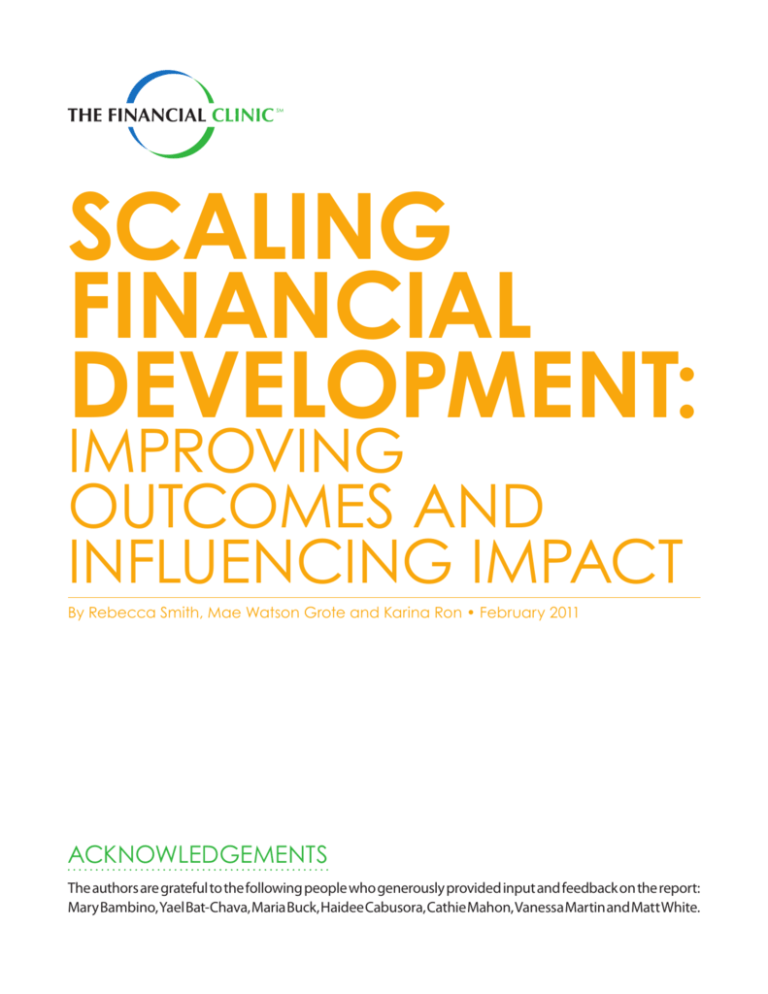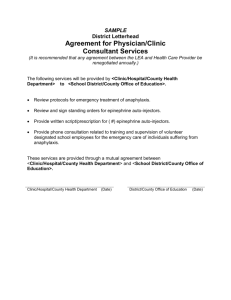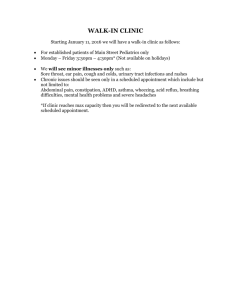
SCALING
FINANCIAL
DEVELOPMENT:
IMPROVING
OUTCOMES AND
INFLUENCING IMPACT
By Rebecca Smith, Mae Watson Grote and Karina Ron • February 2011
ACKNOWLEDGEMENTS
The authors are grateful to the following people who generously provided input and feedback on the report:
Mary Bambino, Yael Bat-Chava, Maria Buck, Haidee Cabusora, Cathie Mahon, Vanessa Martin and Matt White.
INTRODUCTION
High-performing anti-poverty public sector programs and nonprofits are constantly improving
their services that address challenges faced by our nation’s poor and vulnerable populations. From
volume-driven workforce development services to case management-based domestic violence
prevention programs, quality programs often examine their results against the investment they are
making to achieve their missions.
Given the importance of financial security
to a wide range of customers and issues
and the cost of delivering those services,
we at The Financial Clinic asked ourselves:
can financial development services be
embedded into established social service
delivery models to create scale? And, can
financial development services facilitate
the attainment of other organizations’
missions and outcomes?
“[A]sset building is the
‘super vitamin’ that makes
traditional anti-poverty
efforts more successful.”
Jonathan Mintz, NYC Department of Consumer
Affairs, at the CFED Assets Learning Conference,
The Scale Moment Plenary, September 24, 2010.
Within a few years of its founding, The Financial Clinic (the “Clinic”) formulated a theory of change:
scale and impact are achievable by integrating a financial development framework into various
social service delivery models. After dozens of projects, we have sufficient data to conclude that
incorporating financial development into the fabric of preexisting social service missions addresses
customers’ needs holistically and enhances outcomes.
The Clinic, a New York City-based nonprofit organization, exists to build the financial security of
working-poor people. It has provided financial development services to over 6,000 individuals across
all five boroughs of New York City. The Clinic coined the phrase “financial development” to refer
to the wide spectrum of services that can move an individual from financial insecurity to security
and eventually to mobility. Financial
development encompasses the need
for financial education while promoting
behavior change through financial coaching
and support from legal services.
FINANCIAL DEVELOPMENT:
The full range of
educational, coaching
and legal services
that seek to improve
working poor families’
financial security.
The purpose of this report is to
demonstrate how the integration of
financial development into existing social
services can be accomplished and why it
is so powerful. We call on policy makers
nationally to arm themselves with this
strategy to simultaneously create scale and
influence impact.
SCALING FINANCIAL DEVELOPMENT: IMPROVING OUTCOMES AND INFLUENCING IMPACT
© Copyright 2011 The Financial Clinic, all rights reserved.
1
SCALE AND IMPACT
The Clinic’s approach for scale and impact
is integration: by embedding a financial
development framework into a wide range
of social service delivery models, we can
build financial security across a broad
population. The Clinic not only helps to
facilitate more savings, less debt, and greater
uptake of banking products and services,
but most critically, improves the outcomes
of the partner organization as well.
B2B SERVICES: The Clinic’s
capacity-building B2B
services include three
interlocking components:
Technical Assistance to
bolster an organization’s
development and capacity,
ToolKit design to develop
an outcomes framework,
and Training to successfully
implement new services.
To foster financial security among working
poor people, the Clinic works with a variety
of antipoverty organizations to design and
implement new program components in
order to build capacity. The ability to do so
requires a nuanced understanding of what
financial security means for different groups
of people. Survivors of domestic violence, for example, need to work on a different set of action steps
than tax filers at a free tax preparation site. This process is captured in the diagram below:
Stage 1: Map A Financial Development Framework.
Stage 1
Stage 2
Map a
Financial
Development
Framework
* Develop Customized ToolKit
* Design Customized Training
Integrate
Seamlessly
* Streamline Workflow
* Provide Technical Assistance
Stage 3
Enhance
Organizational
Outcomes
* Improve Effectiveness
* Build Efficiency
Working in close consultation with a partner organization, the Clinic designs a customized program
that not only closes financial education gaps, but also hones in on a set of concrete and practical
action steps that support a greater impact. The recommended strategies may resemble milestones
(e.g., download and review a credit report) or outcomes (e.g., improve a credit score), depending on
the specifics of the organization’s program and mission. Through this process, the Clinic gains a deep
understanding of an organization’s programs and mission as well as its culture and constituents.
SCALING FINANCIAL DEVELOPMENT: IMPROVING OUTCOMES AND INFLUENCING IMPACT
© Copyright 2011 The Financial Clinic, all rights reserved.
2
This new framework is supported by a ToolKit (a roadmap for the Clinic’s step-by-step approach to
financial coaching) and staff training (that emphasizes goal-setting, experiential learning and selfadvocacy).
Stage 2: Integrate Seamlessly.
After assessing the partner organization’s services and customer flow, the Clinic proposes an
implementation strategy that is designed to seamlessly integrate the new financial development
services into the organization’s programming. Whether the partner organization successfully
adopts these new strategies depends on how well the services are embedded. As such, the Clinic
focuses on working with the management team to streamline the frontline staff’s workflow, thus
maximizing natural integration points.
Stage 3: Enhance Organizational Outcomes.
As staff become empowered with financial knowledge and equipped with a supportive learning
community, they improve program effectiveness and build systems efficiency. The Clinic’s capacitybuilding shifts its focus towards cross-program synchronization and staff coordination to effectively
engage and motivate customers to commit to achieving organizational outcomes.
The Clinic has applied this process to dozens of nonprofit organizations and public sector entities, both
locally and nationally, including:
4S
upportive housing services in Boston and Chicago;
4C
ommunity colleges in San Francisco; and
4D
omestic violence shelters in New York City.
The wide range of these experiences has helped us confirm that our financial development
framework—encompassing financial education and coaching—is nimble enough to be effective
in any context. As a result, we are committed to adapting the Clinic’s capacity-building services
across a spectrum of social services (from prison re-entry to youth development) and for any
population (from microentrepreneurs to people with disabilities).
SCALING FINANCIAL DEVELOPMENT: IMPROVING OUTCOMES AND INFLUENCING IMPACT
© Copyright 2011 The Financial Clinic, all rights reserved.
3
THEORY OF CHANGE REALIZED
In 2008, the New York City’s Department of Small Business Services (“SBS”), the agency responsible
for the City’s adult workforce services, hired the Clinic to design and integrate program elements
that would improve financial security for low earners. Targeting its Advance at Work program, the
Clinic created and calibrated a set of financial security milestones designed to promote customers’
career advancement:
The Clinic’s Theory of Change
Career Coaches’ New Financial Development Strategies
Financial goals can be a critical impetus to retention
in low-wage, survival jobs as they give purpose and
context to long-term career planning.
Set action-driven, passionately-held financial goals.
Work supports are proven tools that reduce welfare
recidivism and improve job retention.
Secure work supports.
Asset-building pushes workforce development
services from poverty alleviation to financial mobility.
Establish consistent savings through an auto-deduct
feature.
Becoming “banked” and maximizing financial
services supports the career advancement process.
Sign up for direct deposit, with a new bank account
if necessary.
A weak credit history is a barrier to employment as
Download and review a credit report.
more employers use credit reports as a screening tool.
The Clinic then designed program elements that supported the new framework and assisted in
knitting the elements into SBS’s day-to-day career advancement work.
In only nineteen months after the first training, dozens of Career Coaches successfully assisted
customers in downloading over 2,000 credit reports, opening more than 650 bank accounts, and
adding over 500 automatic savings features. Despite their dedicated mission, in the same period of
time a smaller cadre of Clinic Financial Coaches were able to accomplish only a fraction of similar
milestones. Our conclusion was that an agency with the size and reach of SBS can provide financial
development services on a larger scale.
Moreover, our analysis of SBS’s data revealed a positive relationship between achieving financial security
milestones and workforce development outcomes. We studied data from over 1,200 people who worked
with Career Coaches after the Clinic’s engagement. At baseline, participants obtained employment,
second jobs or promotions in connection to their work with a Career Coach. However, the data
demonstrates significantly higher employment and income improvements among participants who
achieved financial security milestones than those who did not.
SBS customers who did not complete a financial security milestone secured, on average, nine more
hours of employment each week, and earned an additional $173 each week, than before they
worked with a Career Coach (see chart on page 5). However, when the Career Coach incorporated
financial development strategies into their work, average hours worked and average income
increased significantly. Further, the more Career Coaches helped build financial security, the better
the outcomes were: participants who achieved two milestones had even better outcomes than those
who achieved one. Customers who achieved two financial security milestones worked 12 more hours
and earned $224 more each week. Those who achieved three financial development milestones
worked an additional 15 hours and earned an additional $219 weekly compared to baseline.
SCALING FINANCIAL DEVELOPMENT: IMPROVING OUTCOMES AND INFLUENCING IMPACT
© Copyright 2011 The Financial Clinic, all rights reserved.
4
FINANCIAL SECURITY MILESTONES IMPACT ON WORKFORCE DEVELOPMENT OUTCOMES
Number of Financial
Security Milestones
Achieved
Additional Hours
Worked*
Percent Change
Additional Income
Earned*
Percent Change
None (baseline)
9
-
$173
-
One
10
11%
$172
(1%)
Two
12
33%
$224
29%
Three
15
67%
$219
27%
*Figures are rounded to the nearest whole number
14
12
12
10
10
8
8
6
6
4
4
2
2
0
0
Average
Average
Customer
CustomerAverage
Average
Customer
Customer
with No
with
Financial
No Financial Who Opened
Who Opened
a Banka Bank
Security
Security
Milestones
MilestonesAccount
Account
(n=291)
(n=291)
(n=391)
(n=391)
IMPACT:
IMPACT:
AUTOSAVINGS
AUTOSAVINGS
ANDAND
WEEKLY
WEEKLY
INCOME
INCOME
$250 $250
Additional Weekly Earnings
14
Additional Weekly Hours Worked
Additional Weekly Hours Worked
IMPACT:
IMPACT:
OPENING
OPENING
A BANK
A BANK
ACCOUNT
ACCOUNT
ANDAND
WEEKLY
WEEKLY
HOURS
HOURS
WORKED
WORKED
Similarly, customers establishing automatic
deposits to create savings earned an average of
$227 more each week (31% higher results than
baseline).
Additional Weekly Earnings
Results were similar when we examined specific
financial development strategies. For example,
customers who opened up a checking or savings
account secured 12 additional hours of work per
week (33% higher results than baseline).
$200 $200
$150 $150
$100 $100
$50 $50
$0
$0
Average
Average
Customer
CustomerAverage
Average
Customer
Customer
with No
with
Financial
No Financial Who Established
Who Established
Security
Security
Milestones
MilestonesAutomatic
Automatic
Savings
Savings
(n=391)
(n=391)
(n=239)
(n=239)
These data demonstrate that, through careful customization and integration of financial security
milestones, the Clinic’s B2B services went beyond simply supporting SBS’s career outcomes and
actually contributed to higher than average impact.
In addition to our own analysis of SBS data and supporting conclusions, an independent, third-party
evaluation of 2,277 SBS customers similarly revealed that customers who achieved financial security
milestones were more likely to receive a promotion or be placed in a new job than those who did not.1
Although both analyses are correlational and do not demonstrate causation, the consistent results
across different studies demonstrate that the achievement of financial security milestones is strongly
associated with workforce outcomes. These results provide a solid analytical foundation for future
evaluation.
SCALING FINANCIAL DEVELOPMENT: IMPROVING OUTCOMES AND INFLUENCING IMPACT
© Copyright 2011 The Financial Clinic, all rights reserved.
5
FUTURE CONSIDERATIONS
Financial development is a strategy that can be adopted across programs, constituents and sectors and
our work is constantly being shaped and refined. The Clinic executes a variety of integration models. We
also develop the institutional knowledge of partner organizations to make effective in-house referrals to
on-site Clinic Financial Coaches. As mentioned previously, the right approach in this range of integration
strategies depends on the culture and constituents of the partnering organization.
As such, we are seriously examining the following issues, which we hope will inform our future capacitybuilding work:
4W
hat are other social service contexts—services for ex-offenders or foster care youth—in which
the impact of integration can be wider in reach or deeper in scope?
4W
e have observed the unintended and positive impact of our work on front-line staff at social
services organizations, who have benefited from this work to improve their own financial security.
Given that many are one paycheck from the people they assist, should financial coaching for case
managers and other staff be a requisite first step of the capacity-building process?
4F
inally, how well integrated do financial development services need to be in order to be effective? Is
it enough to build the capacity and knowledge base of one key person in each program, or must the
organization be the driving change agent?
Now that we have confirmed that integrating financial development strategies into other social
service delivery systems can not only build scale, but also improve impact, the Clinic is committed to
adapting its model to be effective in any context. Ultimately, our collective purpose is to empower
working-poor customers to be savvy consumers who demand high-quality services that will enable
them to move from insecurity to permanent and lasting security.
ENDNOTE
Henderson,Kathryn,CrystalKarakus,andMustafaKarakus.Rep.WorkforceInnovations:OutcomeAnalysisofOutreach,CareerAdvancementandSector-Focused
Programs. New York City Center for Economic Opportunity, Jan. 2010. Web. 3 Dec. 2010.
1
SCALING FINANCIAL DEVELOPMENT: IMPROVING OUTCOMES AND INFLUENCING IMPACT
© Copyright 2011 The Financial Clinic, all rights reserved.
6
BOARD OF DIRECTORS
Rae Linefsky
Chair
C3 Consulting
Maria L. Buck
Secretary
Independent Consultant
Maria Elena Melendez
Treasurer
Mae Watson Grote
The Financial Clinic
Marc Khouzami
DB Climate Change Advisors
Stella Lellos, Esq.
Moses & Singer LLP
Vanessa Martin
MDRC
Sean Wolters
The Solace Group
Matthew B. Zisk, J.D. Ph.D.
Skadden, Arps, Slate, Meagher & Flom LLP
Building financial security and
improving financial mobility.
115 West 30th Street, Suite 702
New York, New York 10001
www.thefinancialclinic.org






